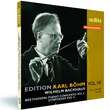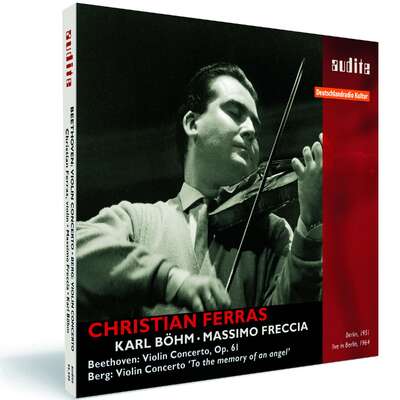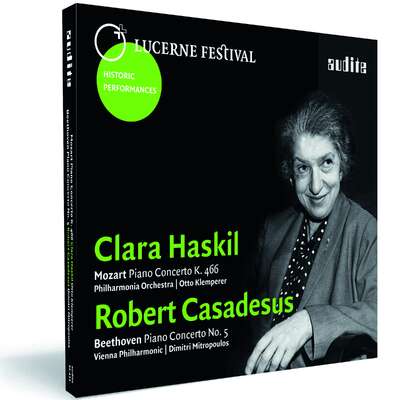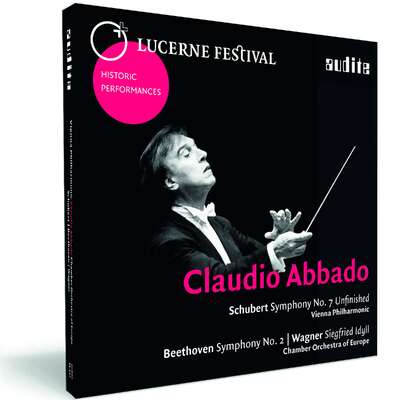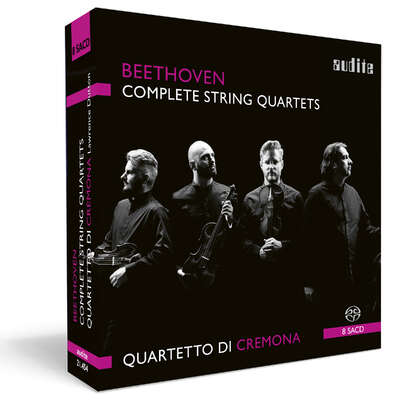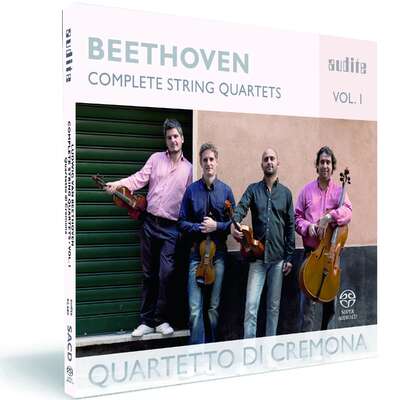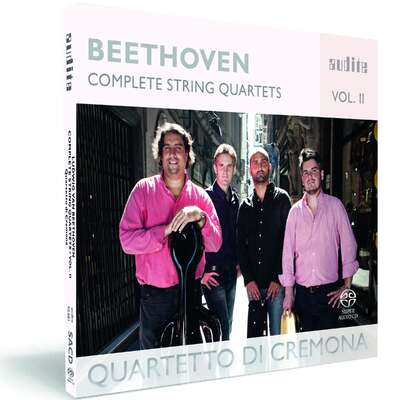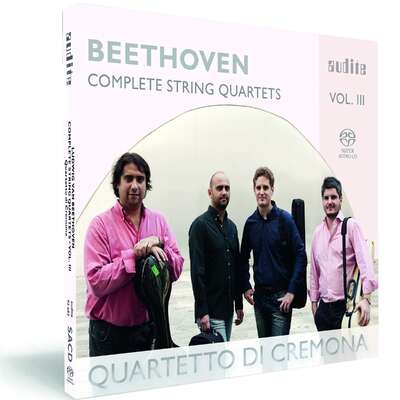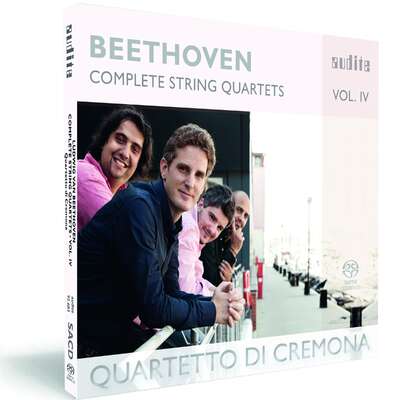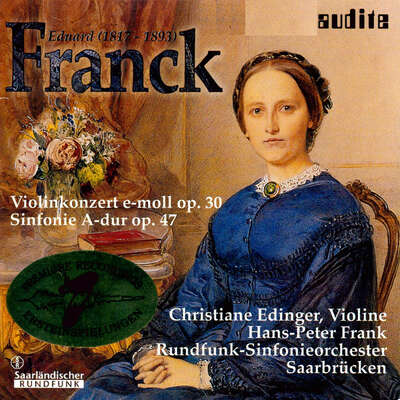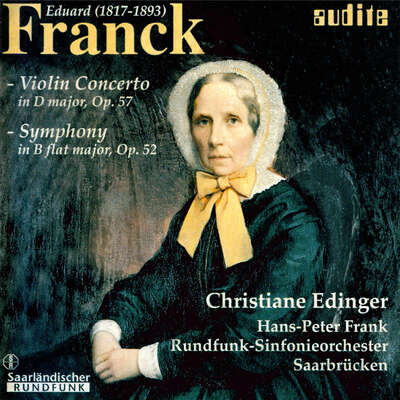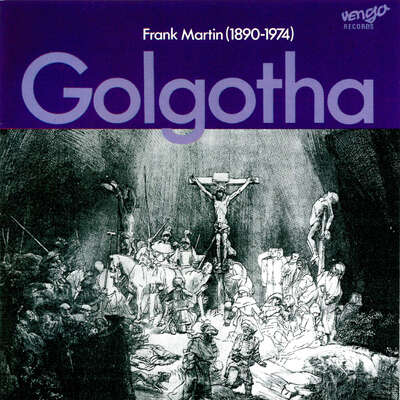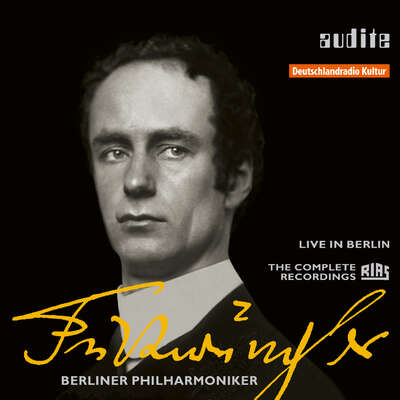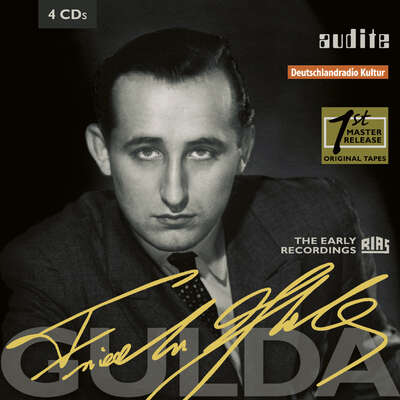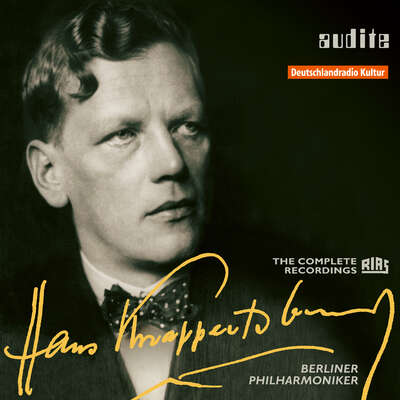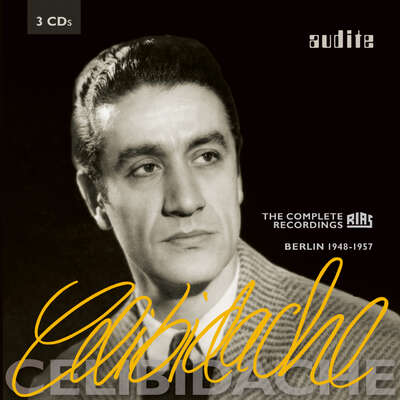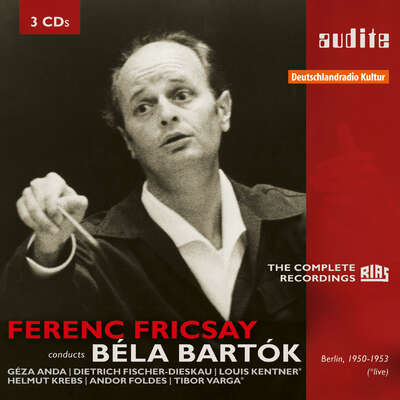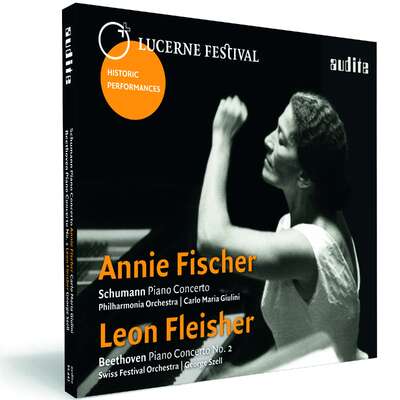
In der künstlerischen Partnerschaft zwischen Karl Böhm und Wilhelm Backhaus herrschte größtes Einvernehmen. Immer wieder begegneten sich die beiden Musiker auf dem Konzertpodium und im Aufnahmestudio, ihre Zusammenarbeit ist in Rundfunk- und Schallplatteneinspielungen vielfach dokumentiert....mehr
"Abgeklärt und ganz in sich selbst ruhend gelingt ihm mit Böhm eine kongeniale Umsetzung der Partitur. Karl Böhms Dirigiertugenden wie Genauigkeit, Disziplin und kapellmeisterliche Strenge finden im klaren Klavierstil des hier bereits 66-jährigen Wilhelm Backhaus ein gleichgewichtiges Gegenüber." (Wochen-Kurier)
Details
| Ludwig van Beethoven: Piano Concerto No. 4 & Symphony No. 4 | |
| Artikelnummer: | 95.610 |
|---|---|
| EAN-Code: | 4022143956101 |
| Preisgruppe: | BCB |
| Veröffentlichungsdatum: | 20. November 2009 |
| Spielzeit: | 69 min. |
Informationen
In der künstlerischen Partnerschaft zwischen Karl Böhm und Wilhelm Backhaus herrschte größtes Einvernehmen. Immer wieder begegneten sich die beiden Musiker auf dem Konzertpodium und im Aufnahmestudio, ihre Zusammenarbeit ist in Rundfunk- und Schallplatteneinspielungen vielfach dokumentiert. Die vorliegende Interpretationen des vierten Klavierkonzertes und der vierten Sinfonie mit dem RIAS Sinfonie-Orchester vom Anfang der 50er Jahre gehören zu den ersten Beethoven-Aufnahmen Karl Böhms nach dem zweiten Weltkrieg. Wilhelm Backhaus zählte Beethovens G-Dur-Klavierkonzert zu seinen Lieblingswerken. Gelassen, abgeklärt und ganz in sich selbst ruhend gelingt ihm mit Böhm eine kongeniale Umsetzung der Partitur. Karl Böhms Dirigiertugenden wie Genauigkeit, Disziplin und kapellmeisterliche Strenge finden im klaren Klavierstil des hier bereits 66-jährigen Wilhelm Backhaus ein gleichgewichtiges Gegenüber.
Zu dieser Produktionen gibt es wieder einen „Producer’s Comment“ vom Produzenten Ludger Böckenhoff unter www.audite.de/sc.php?cd=955610.
Die Produktion ist Teil unserer Reihe „Legendary Recordings“ und tragt das Qualitätsmerkmal „1st Master Release“. Dieser Begriff steht für die außerordentliche Qualität der Archivproduktionen bei audite. Denn allen historischen audite-Veröffentlichungen liegen ausnahmslos die Originalbänder aus den Rundfunkarchiven zugrunde. In der Regel sind dies die ursprünglichen Analogbänder, die mit ihrer Bandgeschwindigkeit von bis zu 76 cm/Sek. auch nach heutigen Maßstäben erstaunlich hohe Qualität erreichen. Das Remastering – fachlich kompetent und sensibel angewandt – legt zudem bislang verborgene Details der Interpretationen frei. So ergibt sich ein Klangbild von überlegener Qualität. CD-Veröffentlichungen, denen private Mitschnitte von Rundfunksendungen zugrunde liegen, sind damit nicht zu vergleichen.
Besprechungen
Gramophone | Gramophone Awards | Geoffrey Norris | 1. Oktober 2013 Emerging triumphant from the flames
It was shunned at its premiere but Beethoven's Fourth Piano Concerto – wildly radical for its time – is now championed by countless performers.Mehr lesen
It's a chilly December evening in Vienna. A good-sized audience has braved the cold and gathered in the unheated Theater an der Wien for a marathon benefit concert featuring the radical composer whom everyone is talking about. He's a bit of an odd ball – often irascible, not a great socialiser, inclined to put people's backs up – but a lot of the music he writes is worth hearing, and he can be relied upon to come up with a surprise or two. Tonight the man himself is going to appear as soloist in his latest piano concerto and, it's rumoured, will do some improvisation in a new piece called Choral Fantasy, which he has knocked together in a hurry because he suddenly realised that a chorus was already on hand to sing parts of his Mass in C. There are to be premieres of two symphonies – his Fifth and Sixth – and a young soprano is standing in at the last moment to sing the scena and aria Ah! Perfido, the composer apparently having had a row with the diva originally booked.
The year was 1808. Beethoven sat down at the keyboard for his Fourth Piano Concerto, which he had already played the previous year at the palace of his well-disposed patron Prince Franz Joseph Maximilian von Lobkowitz. But this was the first time it had been heard by the paying Vienna public. All heads turned towards the conductor for a sign that he was going to give a downbeat for the orchestral introduction. That, after all, was the norm in a concerto in that day and age, but the composer played a quiet G major chord followed by a little questioning phrase, and it was only then that the orchestra came in. What was going on? Back in the 1770s, Mozart had done something similarly unexpected in the Concerto in E flat, K271, but even there the orchestra had the first say. More to the point, the new concerto was not riveting or dynamic: it was more as if the composer were poetically communing with himself. Minds wandered. The public were accustomed to sitting through long concerts, but the four hours and more of this one were taking things a bit far. The audience eventually trooped out of the theatre into the bitter Vienna night, frozen to the marrow and feeling short-changed.
As if that weren’t enough…
The uncomprehending reception of the Fourth Piano Concerto was just one of the misfortunes to beset this all-Beethoven night on December 22, 1808: the orchestra, ill-rehearsed and annoyed with Beethoven over some earlier misdemeanour, fell apart in the Choral Fantasy and the piece had to be started again. And far from being a benefit night for Beethoven, it is thought that he hardly managed to break even. The G major Concerto never really entered the core repertoire until Mendelssohn – that youthfully perceptive and vigorous campaigner on behalf of unjustly neglected causes, Bach included – rescued it in the 1830s. Clara Schumann took it up in the 1840s. In the 1860s Hans von Billow played it. Anton Rubinstein played it. Liszt admired it. The Fourth gradually overcame its unpromising entry into the world – as such ground breaking and unusual music is so often prone to do – and entered the canon of Beethoven's regularly performed concertos. These days its reception is immeasurably more favourable than that which its first audience was prepared or equipped to give it, and there is no shortage of recordings in the current catalogue. From a long list, I have selected for this comparative review 20 versions that represent some of the great names of the past and a cross-section of the young and seasoned artists of today.
From the earlier era there are Artur Schnabel (recorded 1933), Willhelm Backhaus (1950), Claudio Arrau (1957), Emil Gilels (1957), Wilhelm Kempff (1961), Daniel Adni (1971) and Clifford Curzon (1977). From more recent times, Maurizio Pollini (1992, as well as 1976), Alfred Brendel (1997), Pierre-Laurent Aimard (2002), Daniel Barenboim (2007, plus 1967), Evgeny Kissin (2007), Lang Lang (2007), Till Fellner (2008), Paul Lewis (2009) and Yevgeny Sudbin (2009). In a special category, Arthur Schoonderwoerd (2004) plays a period Johann Fritz piano; and on a modern Steinway Ronald Brautigam (2007) adopts Beethoven's revisions as published by Barry Cooper in 1994.
The matter of time
There is a whole world of difference here between, at the one extreme, the versions by Claudio Arrau, Daniel Adni and the earlier of Daniel Barenboim's two (all of them conducted by Otto Klemperer) and, at the other end, Brautigam's performance with the Norrköping Symphony Orchestra under Andrew Parrott. Whereas Klemperer exploits the full sumptuousness of the (New) Philharmonia Orchestra and takes about 20 minutes to negotiate the first movement, Parrott adopts 'period aware' thinking and sharper pacing with scant vibrato, and clocks up a running time of about 17 minutes for the first movement. That is about the norm in most of the recordings apart from Klemperer's, and, eminent though his performances are, the music does exude an air of lingering in a way that would certainly not have appealed to that first Vienna audience in 1808. Pierre-Laurent Almard with the Chamber Orchestra of Europe under Nikolaus Harnoncourt, Lang Lang with the Orchestre de Paris under Christoph Eschenbach and Evgeny Kissin with the London Symphony Orchestra under Sir Colin Davis all demonstrate a slowness in this first movement – but it doesn't necessarily lead to languor. At times, however, it's a close-run thing, and in other versions the music certainly has more of a lift and a natural flow. Daniel Barenboim, conducting the Staatskapelle Berlin from the keyboard, shaves off just over a minute from the time he took under Klemperer, and the result is a performance that has power, concentration and crucial momentum.
Ronald Brautigam's pacing comes in at about the average, and his recourse to Beethoven's revisions is an interesting facet of his polished and discreetly shaped interpretation: the addition of more florid passages and extra notes and some chopping and changing of register lend the concerto a different perspective – more decorative and, in Cooper's words, 'strikingly inventive and more sparkling, virtuosic and sophisticated than the standard one'. Since these revisions are in Beethoven's own hand on the copyist's orchestral score, it is likely that he himself played it in much this way at the 1808 concert, though other artists have not yet followed his or Brautigam's example, at least on disc.
Going the whole hog in speculative performance practice, Arthur Schoonderwoerd on his fortepiano of 1805-10 actually comes in as the quickest exponent of the first movement by the stopwatch, but curiously he also sounds the most effortful, and those wiry, nasal old instruments in the reduced orchestral ensemble of Cristofori are very much an acquired taste.
If it is probably wise to eliminate Klemperer's three recordings from the final reckoning in terms of repeated listening, Artur Schnabel's 1933 performance is testament both to his brilliant artistry and to his characterful interpretative style. The remastered sound is not at all bad, and the relationship with the London Philharmonic Orchestra under (the not then Sir) Malcolm Sargent is secure and spontaneous. One might baulk at the slight ratcheting up of tempo when the piano re-enters at bar 74 of the first movement: Sargent faithfully adheres to the speed that Schnabel suggests during his opening phrase, but Schnabel then decides that he wants things to go a bit quicker after the long orchestral tutti. There are also some orchestral glissandi that speak of the practice at the time when this recording was made, but they do not unduly obtrude and the performance is one of infectious spirit, even if the finale does sometimes threaten to break free of its leash. Of the other 'historical' performances, Wilhelm Backhaus's with the RIAS Symphony Orchestra under Karl Böhm is of an impressive seriousness and eloquence of expression. The Fourth, recorded live in Berlin, was a favourite concerto of Backhaus, one in which he manifested his reputation as a 'devotedly unselfish mouthpiece' for the composers he was playing. This by no means implies a lack of imagination, for Backhaus's performance is one that combines serenity and vitality and also conveys a sure grasp of the concerto's structure. So, too, do Alfred Brendel and the Vienna Philharmonic under Simon Rattle, and Maurizio Pollini in characteristically translucent yet powerful fashion with the Berlin Philharmonic under Claudio Abbado and earlier on with the Vienna Philharmonic under Böhm. From more recent times, there are similarly well-reasoned performances from Till Fellner with the Montreal Symphony Orchestra under Kent Nagano, Paul Lewis with the BBC Symphony Orchestra under Jirí Belohlávek and Yevgeny Sudbin with the Minnesota Orchestra under Osmo Vänskä. I cannot pretend that comparisons between any of these make the choice of a preferred version any easier: all of them have searching qualities and interpretative personalities that seem to be in harmony with the music's disposition.
The cadenza issue
Alfred Brendel's performance does, however, raise the interesting question of the cadenzas. Beethoven wrote two for the first movement and one for the last. Many other composers and pianists have supplied their own over the years, including Brahms, Busoni, Godowsky, Saint-Saens and Clara Schumann. Wilhelm Kempff preferred to use his own cadenzas for his recording with the Berlin Philharmonic under Ferdinand Leitner, as does Arthur Schoonderwoerd with Cristofori. Other pianists are divided, if not equally, between Beethoven's two first-movement cadenzas. The one most commonly favoured begins in 6/8 with a quickened-up version of the opening theme in repeated Gs in the right hand. The other, starting with soft octave Gs in the left hand, builds to a swift climax and a torrent of descending thirds. Alfred Brendel and Maurizio Pollini are among the proponents of this more ominous, wilder – if shorter – cadenza, and in his book Music Sounded Out (1995, page 57) Brendel gives his reasons. 'May I assure all doubting Thomases', he says, 'that the cadenza I play in the first movement of the Fourth Concerto is indeed Beethoven's own; the autograph has the superscription Cadenza ma senza cadere ['Cadenza, but without falling down'] ' an allusion to its pianistic pitfalls. I have often been asked why I should waste my time on this bizarre piece when another more lyrical, and plausible, cadenza is available. I think that the [superscription) adds something to our knowledge of Beethoven. It shows almost shockingly how Beethoven the architect could turn, in some of his cadenzas, into a genius running amok. Almost all the classical principles of order fall by the wayside, as comparison with Mozart's cadenzas will amply demonstrate. Breaking away from the style and character of the movement does not bother Beethoven at all, and harmonic detours cannot be daring enough. No other composer has ever offered cadenzas of such provoking madness.' If someone else had written this weird cadenza, he or she would surely have been roundly condemned for shattering the mood of the first movement, but, as it is, it is there as an entirely justifiable option. Brendel's performance of it certainly underlines his point about Beethoven's genius running amok, and the cadenza delivers a similar blow to the senses in the two recordings by Maurizio Pollini. If the choice of the first-movement cadenza is a major factor in your enjoyment of the Fourth Concerto, then this needs to be taken into account. Backhaus, incidentally, plays the 'usual' Beethoven cadenza in the first movement, but his own stormy, bravura one in the finale.
There is one recording that has not so far been mentioned. In an effort to keep up the suspense about the ultimate choice in this Fourth Piano Concerto (though the boxes scattered about this review will already have given more than a clue), I have not yet put forward the name of Emil Gilels. Strictly speaking, his recording comes in the historical category, since it was made in 1957 with the Philharmonia Orchestra under Leopold Ludwig, but its sound is exceptionally well remastered and it is a performance of transcendent beauty allied to power, delicacy, control and a palette of colour – both in the piano and in the orchestra – that is second to none. Gilels was in his maturity when he made this sublime recording (coupled with the Fifth Concerto) at the age of 41, and it testifies to the stylistic understanding and thoughtful qualities that distinguished his piano-playing at its best. The first movement is eloquently voiced – 'poetry and virtuosity are held in perfect poise', as a Gramophone review rightly put it; and he gives a vibrant account of the wilder first-movement cadenza that Brendel and Pollini also prefer.
Pinning all one’s hopes on the slow movement
When it comes to the short slow movement, the dialogue between the aggressive orchestra and the ameliorating piano is judged immaculately and poignantly by Ludwig and Gilels.It was the critic Adolf Bernhard Marx who (in 1859) propounded the theory that this movement could be viewed as an analogy of Orpheus pacifying the Furies at the gates of Hades, a romantic notion that has held sway ever since. Whatever was in Ludwig's and Gilels's minds, the orchestra's gradual acquiescence under the piano's gently persuasive influence is pure magic. By contrast, on Clifford Curzon's recording with the Bavarian Radio Symphony Orchestra under Rafael Kubelik – a performance that is otherwise of great distinction – the orchestra sounds merely a bit blunt rather than hostile. Nagano has his Montreal Symphony Orchestra tripping lightly on Fellner's recording; Böhm sounds ominous, if a little ponderous, for Backhaus, though Backhaus's own playing is melting. Leitner gives something appropriately stern for Kempff to answer on his recording. Sargent's crisp note values observe the sempre staccato marking at the start of the slow movement and thus give the music more bite for Schnabel. Belohlávek and Lewis also manage this discourse effectively, as do Rattle and Brendel. It is debatable whether either Abbado or Böhm on Pollini's recordings makes adequate distinction between the two parties in the same, almost visually palpable, way that Ludwig and Gilels do, and on Sudbin's otherwise first-rate recording Vänskä coaxes a surprisingly soft-edged attack from the Minnesota Orchestra at this juncture.
It is odd, perhaps, that after barely being able to put a pin between a good many of the available recordings of the Fourth Concerto, so much should hinge on how the orchestra reacts to the piano in the slow movement, and vice versa. The finales do not disappoint in any of the leading versions, but with the slow movement proving to be, if subjectively, a point where some performances are more clearly defined in impact than others, the final choice would seem to rest on five versions: Backhaus and Böhm with the RIAS Symphony Orchestra from 1950, Gilels with the Philharmonia Orchestra under Ludwig from 1957, Kempff with the Berlin Philharmonic and Leitner from 1961, Brendel and Rattle with the Vienna Philharmonic from 1997 and Lewis with Belohlávek and the BBC Symphony Orchestra from 2009. In addition, there is an irresistible élan to Schnabel's 1933 performance with the London Philharmonic Orchestra under Sargent, and much of textural and interpretative interest in the 2007 version by Brautigam and the Norrköping Symphony Orchestra under Parrott.
The last of these, being the only one to adopt Beethoven's manuscript revisions to the concerto, comes across with a different sort of scintillating zest that is particularly attractive, and the disc (with the piano arrangement of the Violin Concerto as coupling) could be a refreshing addition for anybody wanting a companion to a recording of the received version. Schnabel, Backhaus and Kempff in their different ways bring timeless musicianship to their interpretations, but the mix of vitality and visionary expressiveness in the Backhaus just gives that one the edge – remembering, though, that he plays his own cadenza in the finale. With the recording by Brendel and Rattle (Brendel's third recording of the Fourth Concerto, the others being with Bernard Haitink and James Levine) there is a true meeting of musical minds, the orchestra and piano establishing a mutual understanding of their roles in the expressive and dynamic scheme of things. The interpretative bond between Lewis and Belohlávek is similarly a close and fertile one and has forged not only a compelling performance of the Fourth Concerto but also a complete set of all five. But when it comes down to it, the special qualities of Gilels – his poetry, power and poise – put him prominently in prime place.
Crescendo Magazine | mise à jour le 18 novembre 2010 | Bernard Postiau | 18. November 2010
Contrairement au disque Strauss que nous avons reçu parallèlement àMehr lesen
www.ResMusica.com | 03/11/2010 | Patrick Georges Montaigu | 3. November 2010 Beethoven Böhm Backhaus : du grand classique, mais pas très nouveau
Puisant dans la riche réserve d’enregistrements réalisés à partir desMehr lesen
American Record Guide | July-August 2010 | William Bender | 1. Juli 2010
It probably needn’t be said that these two works belong together like Cavalleria Rusticana and I Pagliacci, the two one-act operas MetropolitanMehr lesen
Backhaus and Bohm had been concerto partners, and friends, in the years before World War II (their two Brahms concertos remain popular reissues to this day on Naxos and Biddulph), and this reading of Beethoven 4 in 1950 Berlin was one of their first post-war get-togethers, if not the first reunion itself. Both were done for broadcast, the concerto before an audience in the Titania Palast, the symphony in a 1952 “studio” recording in the Jesus Christ Church, both places regularly favored by the Berlin Philharmonic. The RIAS Symphony was Ferenc Fricsay’s orchestra, which since 1948 he had quickly built into a first-rate ensemble. Berlin was still divided into East and West, and RIAS stood for Radio in the American Sector. Audite tells us that the sound heard here was drawn from the original broadcast reel-to-reel tapes. The result is very easy on the ears, though the treble is limited and the bass line is sometimes blurry.
The symphony is done in Bohm’s usual no-nonsense style, and is endearing. I do not know his later set of the Beethoven nine with the Vienna Philharmonic, but I would be surprised if the Vienna Fourth were as genial, as courtly even, as this one with the RIAS. It is one of Beethoven’s more mysterious works. Many a prominent conductor has foundered on its innocent shoreline, trying to lay on meaning and profundity that might have astonished the composer. Bohm seems to have succeeded by simply turning the music over to the orchestra. It often seems that way with Bohm. But it is of course never that simple. He works hard for it in rehearsal. The minuet (III) is perhaps the most charming thing in the performance. At the end of each section—the beginning minuet, the trio, and then the movement itself—Böhm introduces gentle retards that are not called for in the score but are certainly permissible and are like farewell curtsies of a bygone rococo era—and charming.
Wilhelm Backhaus brings one of the 20th Century’s great piano techniques to bear on the piano concerto, with electrifying results. He had a familiar ability to make every passage, every phrase, sound just right, ever so easy, fully at the service of the music. This was done without a hint of showing off, unless it be in a cadenza—but even there he seemed to stay cool. Over the years that glistening pearlywhite tone was ceaseless in its ability to pierce even the thickest of orchestral sonorities, though Beethoven’s discreet orchestrations do not present that kind of challenge. Nor does the man on the podium here.
There is one debatable interpretive moment that occurs right at the start with the piano’s delicate solo opening. Beethoven gives seemingly contradictory directions for this passage. The dots over the piano’s notes are the familiar indication that the composer wants the music played staccato, or detached. But he also writes p, for soft, and dolcefor sweet. Is it possible to do both? Backhaus clearly favors the staccato approach, though he does his best to be quiet about it. Going back to Leon Fleisher’s 1959 recording with George Szell and the Cleveland Orchestra (most recently on Sony 48165), one is charmed and convinced by his half-voiced emphasis on the soft and the sweet. Surely Beethoven must have wanted it that way, as a beckoning contrast to what was to follow. Artur Schnabel thought so too in his three recordings of the piece.
Diapason | N° 581 juin 2010 | Rémy Louis | 1. Juni 2010
Plusieurs parutions (Audite, Hänssler...) ont permis récemment de saluer Karl Böhm interprète straussien. Cœur de ce CD inédit – Don JuanMehr lesen
Les valses du Chevalier à la rosé révèlent ensuite une perception très sûre du contexte dramaturgique de l'opéra. L'accentuation savante et la décontraction du ton sont réjouissantes, à mi-chemin entre Vienne et Munich – et quelle transparence, là encore! Mise au service d'un univers tout autre, elle illumine également un Opus 58 de Beethoven d'un son glorieux (plus que l'édition Tahra), pour les mêmes raisons que ci-dessus. On a l'impression d'assister à ce concert donné en 1950 au Titania-Palast. Onze ans après la singulière gravure avec Gieseking (et Dresde, Emi, 1939), Böhm converse cette fois avec Wilhelm Backhaus. Passion de la clarté, exigence de l'articulation, ferveur rhétorique, flamme intérieure: le maître allemand sculpte le détail au sein du grand geste – la cadence de l'Allegro est extraordinaire, le finale irrésistible. Influence de l'air berlinois ? Dans l’Andante con moto, le legato de Böhm a des tentations furtwänglériennes, plus que dans aucune autre de ses versions (avec Backhaus encore, puis Pollini).
Enregistrée en studio, claire de lignes et assez sombre de propos, la Symphonie n° 4 (inédite, 1952) est intrigante dans son ambiguïté même. Aucun autre de ses témoignages ne donne à l’Adagio introductif une telle densité attentiste, comme une anticipation du début de l'acte II de Fidelio. Un choix volontaire, car l'émotion qui sourd de l’Adagio central participe encore d'une autre nuance expressive, plus lyrique, mélancolique aussi. Etrangers aux imprécations d'un Scherchen (Tahra) comme aux ivresses de Carlos Kleiber (Orfeo), les tempos de Böhm paraîtront sans nul doute modérés pour nos habitudes actuelles (il est vrai que certains sforzatos manquent parfois de tension). Mais, comme souvent, l’élan intérieur et l’animation incoercible du discour demeurent.
Fanfare | Monday, 10 May 2010 | Mortimer H. Frank | 10. Mai 2010
This release is tagged Volume 7 in Audite's ongoing series devoted to Karl Böhm. The concerto is a live account dating from 1950 and may well proveMehr lesen
As for the Symphony No. 4, one wonders if this 1952 studio recording was ever previously released – it is not cited in either of the two WERM supplements. (Perhaps a limited issue was produced and confined to Germany.) Sonically it marks a big improvement over the concerto: less harsh if still a bit edgy and remarkable in its wide dynamic range and freedom from the once-common tape-hiss. Musically, it is very close to Böhm's 1972 stereo account for DG with the Vienna Philharmonic, the one marked difference between them being this earlier version's having a few rhetorical emphases in the third movement that the later account avoids. Both include exposition repeals in outer movement and offer tempos that, if slightly broader than usual, remain eminently musical. In short, this is a significant historical release.
Pizzicato | N° 200 - 02/2010 | Alain Steffen | 1. Februar 2010 Große Meister
War es möglich, knapp fünf Jahre nach den Gräueln des Zweiten Weltkriegs die Musik von Johann Strauss so sorglos und naiv zu spielen, wie in denMehr lesen
Auch bei dem Beethoven-Programm mit Backhaus und Karl Böhm wird der Musikliebhaber auf seine Kosten kommen. Backhaus spielt wie ein junger Gott, leichtfüßig und voller Poesie, technisch überlegen und musikalisch einwandfrei. Das hervorwagende Remastering dieser CD lässt durch ihre Transparenz zudem wundervolle Feinheiten in Backhaus' Spiel erkennen. Karl Böhms Beethoven wirkt eher klassisch und entspricht dem damaligen Zeitgeist. Trotzdem sind seine beiden Interpretationen hörenswert, zumal er gerade bei der 4. Symphonie in ungeahnte Tiefen vorstößt und diese Symphonie als ein tatsächliches Nachfolgewerk der großen Eroica versteht.
Welch ein Ereignis, den großen Wilhelm Backhaus hier in drei Live-Mitschnitten aus der New Yoker Carnegie Hall zu hören. Das 4. Klavierkonzert stammt vom 18. März, die Sonate op. 10 Nr. 1 vom 11. April 1956, der ganze Rest ist das komplette Konzert mit Zugaben, das Backhaus am 30. März 1954 im Alter von 70 Jahren gespielt hat: Das reine Beethoven-Programm setzte sich aus den Sonaten op. 13 'Pathetique', op.79. op. 31/2 'Der Sturm', op.81a 'Les Adieux' und op. 111 zusammen, die Zugaben stammen von Schubert, Schumann, Liszt und Brahms. Wir erleben einen erstaunlich jung gebliebenen Pianistin, der mit filigraner und sicherer Technik einen sehr leichten Beethoven spielt. Die Virtuosität ist immer präsent, doch sie hält sich quasi mit einem Augenzwinkern im Hintergrund. Backhaus erweist sich als ein Meister der Gestaltung. Die Melodien fließen mit einer atemberaubenden Natürlichkeit, und die Tiefe ergibt sich aus der Schlichtheit. Zudem wirkt das Programm trotz der unterschiedlichen Sprachen der Sonaten genau so geschlossen und zwingend, wie die Interpretationen. Hoch interessant und so gar nicht im Stil der Fünfzigerjahre ist das 4. Klavierkonzert mit Guido Cantelli am Pult der New Yorker Philharmoniker. Schlank, virtuos und doch getragen von einem tiefen Verständnis nimmt diese Interpretation bereits den 'modernen' Beethoven der Sechziger- und Siebzigerjahre vorweg und zeigt auf eine sehr schöne Weise, wie fließend dieser Stilübergang sein kann und, dass selbst ein Pianist, der noch im 19. Jahrhundert debütiert hat, diese Modernität mitgetragen hat. Im Gegensatz zu Karl Böhm ist Guido Cantelli virtuoser im Umgang mit dem Orchestermaterial und bezieht sich eher auf die Leuchtkraft eines Mozart. Nur hängt diese New Yorker Aufnahme der Berliner klanglich weit hinterher.
Vladimir Horowitz war dreiundachtzig Jahre alt, als er sein umjubeltes Konzert vom 18. Mai 1986 in der Berliner Philharmonie gab. „Himmlischer Horowitz – Die Berliner weinten in der Philharmonie“ konnte man in der Presse vom 20. Mai lesen. Und in der Tat, beim Abhören dieses Mitschnitts spürt man sofort das Großartige und Einmalige dieses Abends. Das Publikum reagierte entfesselt, Horowitz ließ noch einmal seine ganze Kunst aufblitzen. Einmalig die drei Sonaten von Scarlatti, wunderbar Schumanns 'Kreisleriana'. Und natürlich gibt Horowitz gerade bei den beiden russischen Komponisten Rachmaninov und Scriabin sein Bestes, zeigt, wie edel, uneigennützig und wahr man als Pianist diesen publikumswirksamen Stücken begegnen kann. Ein in der Tat historisches Konzert.
Audiophile Audition | January 25, 2010 | Gary Lemco | 25. Januar 2010
The Karl Bohm (1894-1981) legacy here embraces two sessions with FerencMehr lesen
www.ClassicsToday.com | January 2010 | David Hurwitz | 1. Januar 2010
Fresh from their denazification hearings, Backhaus and Böhm team up for aMehr lesen
www.classicstodayfrance.com | Janvier 2010 | Christophe Huss | 1. Januar 2010
On en apprend à tout âge et il faut toujours écouter attentivement! Il yMehr lesen
Wochen-Kurier | Nr. 51 - Mittwoch, 23. Dezember 2009 | Michael Karrass | 23. Dezember 2009
In der künstlerischen Partnerschaft zwischen Karl Böhm und WilhelmMehr lesen
Der neue Merker | Montag, 23. November 2009 18:39 | Dorothea Zweipfennig | 23. November 2009
Audite: November-Veröffentlichungen präsentieren zwei große Dirigenten,Mehr lesen
Neuigkeiten
On en apprend à tout âge et il faut toujours écouter attentivement! Il y a...
Fresh from their denazification hearings, Backhaus and Böhm team up for a...
It probably needn’t be said that these two works belong together like...
Contrairement au disque Strauss que nous avons reçu parallèlement à celui-ci,...
Beethoven Böhm Backhaus : du grand classique, mais pas très nouveau
This release is tagged Volume 7 in Audite's ongoing series devoted to Karl...
Plusieurs parutions (Audite, Hänssler...) ont permis récemment de saluer Karl...
The Karl Bohm (1894-1981) legacy here embraces two sessions with Ferenc...
In der künstlerischen Partnerschaft zwischen Karl Böhm und Wilhelm Backhaus...
Audite: November-Veröffentlichungen präsentieren zwei große Dirigenten, denen...
